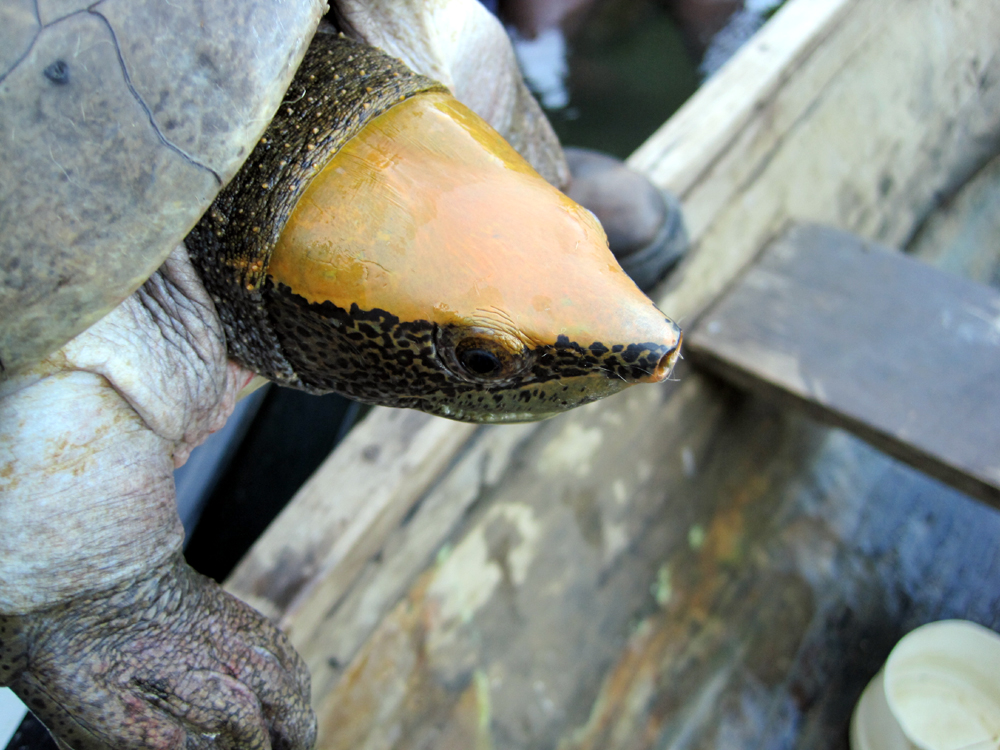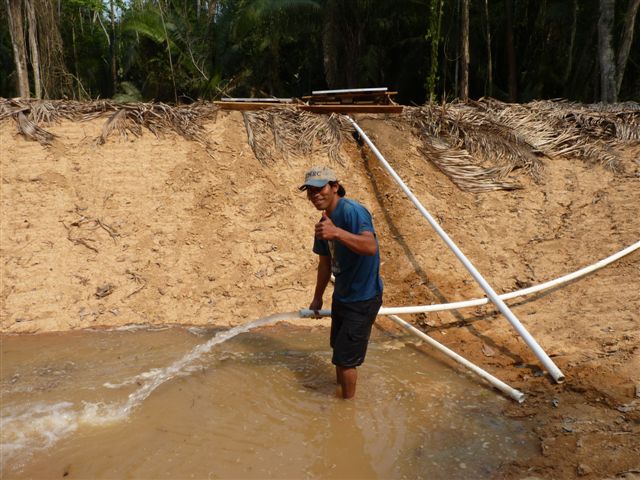Central American River Turtle Facility Near Completion
by Heather Lowe 
 Last year (2010), the Turtle Survival Alliance (TSA) conducted a country-wide survey in Belize to assess the current conservation status of Dermatemys in what is believed to be its last stronghold. Results of the survey indicated that Dermatemys (locally known as “hicatee”) is heavily depleted in most of Belize, but healthy populations remain in a few remote areas. Then, in March 2011, we reported on two training workshops that Thomas Rainwater conducted in Belize, basically building capacity for long-term monitoring of Hicatee (Dermatemys) populations in the wild. In parallel with these efforts, the TSA has advanced the concept of developing a captive program that could meet several long-term goals including building an assurance colony and providing headstarted turtles for restoring depleted wild populations. Unfortunately, we believe that Hicatee populations will likely continue to decline across their range and in ten years could only exist as isolated populations in remote areas. Eating Hicatee is too culturally ingrained to simply go away. Restoration efforts may depend on headstarting and release or translocations, and this effort will need to be done to scale. Small breeding efforts will not be sufficient. The TSA believes that we should develop the basic captive techniques now and begin to lay the foundation for what may be inevitable.
Last year (2010), the Turtle Survival Alliance (TSA) conducted a country-wide survey in Belize to assess the current conservation status of Dermatemys in what is believed to be its last stronghold. Results of the survey indicated that Dermatemys (locally known as “hicatee”) is heavily depleted in most of Belize, but healthy populations remain in a few remote areas. Then, in March 2011, we reported on two training workshops that Thomas Rainwater conducted in Belize, basically building capacity for long-term monitoring of Hicatee (Dermatemys) populations in the wild. In parallel with these efforts, the TSA has advanced the concept of developing a captive program that could meet several long-term goals including building an assurance colony and providing headstarted turtles for restoring depleted wild populations. Unfortunately, we believe that Hicatee populations will likely continue to decline across their range and in ten years could only exist as isolated populations in remote areas. Eating Hicatee is too culturally ingrained to simply go away. Restoration efforts may depend on headstarting and release or translocations, and this effort will need to be done to scale. Small breeding efforts will not be sufficient. The TSA believes that we should develop the basic captive techniques now and begin to lay the foundation for what may be inevitable.
 However, given the rather dismal history that Dermatemys has experienced in captivity, we recognize the need to better understand the reproductive biology of this species under artificial conditions. In response to this, the TSA launched a partnership with the Belize Foundation for Research and Environmental Education (BFREE), a non-profit with 18 years of experience conducting conservation work in Belize. The goal of this collaboration is to build the Hicatee Conservation Research Center (HCRC) at BFREE where we could answer some basic questions about Dermatemys in captivity (where they lay their eggs for example), and to test the feasibility of large scale captive management. After a number of site visits by Rick Hudson (TSA President) and consultants Dave Manser (Ponds and Plants) and Rob Crook (Floating Islands Southeast), plans for the facility were underway by the beginning of the year. With start-up funds provided by the Batchelor Foundation, construction of the HCRC began in February 2011. The site is located on two acres of tropical broadleaf rainforest within the 1,153 acre BFREE private reserve in southern Belize, and is under the direction of Jacob Marlin.
However, given the rather dismal history that Dermatemys has experienced in captivity, we recognize the need to better understand the reproductive biology of this species under artificial conditions. In response to this, the TSA launched a partnership with the Belize Foundation for Research and Environmental Education (BFREE), a non-profit with 18 years of experience conducting conservation work in Belize. The goal of this collaboration is to build the Hicatee Conservation Research Center (HCRC) at BFREE where we could answer some basic questions about Dermatemys in captivity (where they lay their eggs for example), and to test the feasibility of large scale captive management. After a number of site visits by Rick Hudson (TSA President) and consultants Dave Manser (Ponds and Plants) and Rob Crook (Floating Islands Southeast), plans for the facility were underway by the beginning of the year. With start-up funds provided by the Batchelor Foundation, construction of the HCRC began in February 2011. The site is located on two acres of tropical broadleaf rainforest within the 1,153 acre BFREE private reserve in southern Belize, and is under the direction of Jacob Marlin.
 Since breaking ground in February, three large ponds have been installed (two breeding ponds, 100’ x 80’ and 120’ x 60’, and one bio-filtration/food pond, 50’ x 40’). A freshwater well has been dug and reinforced, a pump house has been constructed over the well, and a solar system has been installed to power the submersible solar water pump. Fresh water is pumped automatically into the ponds when the sun rises each day and turns off at dusk. Overflow from the breeding ponds flows into the bio-filtration pond where semi-aquatic food plants will be grown. Currently, the ponds are being kept full and are being allowed to settle and find some equilibrium. When finished, the HCRC will house close to fifty adult breeding Hicatee and all of their food plants will be raised on site. Because of natural predators living in the area (jaguars, mountain lions, ocelots, coatis, etc), a ten- foot chain-link electrified fence will encircle the ponds to keep out unwanted guests. TSA and BFREE hope to procure the breeding stock from the illegal meat trade directly at local markets in Belize in early 2012. Completion of the HCRC is planned for December 2011, and we hope the facility will be fully operational by March 2012.
Since breaking ground in February, three large ponds have been installed (two breeding ponds, 100’ x 80’ and 120’ x 60’, and one bio-filtration/food pond, 50’ x 40’). A freshwater well has been dug and reinforced, a pump house has been constructed over the well, and a solar system has been installed to power the submersible solar water pump. Fresh water is pumped automatically into the ponds when the sun rises each day and turns off at dusk. Overflow from the breeding ponds flows into the bio-filtration pond where semi-aquatic food plants will be grown. Currently, the ponds are being kept full and are being allowed to settle and find some equilibrium. When finished, the HCRC will house close to fifty adult breeding Hicatee and all of their food plants will be raised on site. Because of natural predators living in the area (jaguars, mountain lions, ocelots, coatis, etc), a ten- foot chain-link electrified fence will encircle the ponds to keep out unwanted guests. TSA and BFREE hope to procure the breeding stock from the illegal meat trade directly at local markets in Belize in early 2012. Completion of the HCRC is planned for December 2011, and we hope the facility will be fully operational by March 2012.
